William R. Albury
George M. Weisz
New South Wales, Australia
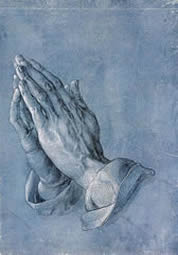
Praying hands,
c. 1508, Albrecht Dürer
Brush drawing on
blue primed paper
Albertina Museum
Vienna, Austria
The image of Praying Hands by Albrecht Dürer, painted on an altarpiece in the sixteenth century and destroyed by fire in the seventeenth century, has come down to us in the form of a preparatory drawing on blue-grey paper (Fig. 1). The popularity of this image is impressive because of its religious connotations and artistic beauty. The drawing has been the subject of many descriptions and much speculation about the intentions of the artist and the source of the hands he depicts. The present article notes some specific pathological features of these hands and uses computer-assisted tracings to identify their model in an earlier work by the Italian artist Andrea Mantegna.
Albrecht Dürer
Albrecht Dürer (1471–1528) was the first master draftsman in German Renaissance art. After completing a youthful tour of Northern Europe and returning to his birthplace of Nuremberg, he set off for Italy twice, in 1494 and again in 1505. He had already been introduced to Humanist thought before his departure and was acquainted with some Italian paintings and engravings that existed in his native city.
While in Italy, Dürer studied perspective, geometrical representation, and human proportions. He was exposed to the ideas of such figures as the architect Leon Battista Alberti (1404–1472), the painter and scientist Leonardo da Vinci (1452–1519), the mathematician Luca Paccioli (1446–1517), and the painter/geometrician Jacopo de Barbari (fl. c. 1500).1 Dürer’s experience in Italy had a profound effect on his art. He was able to synthesize German and Italian pictorial styles, and introduced Italian Renaissance aesthetic concepts into Germany. As art historians have recognized, it “was Dürer who initiated what is called the Renaissance in the north”2
Dürer’s Praying Hands
Dürer’s Praying Hands of an Apostle, dated 1508, has become his most renowned drawing. It is repeatedly reprinted in art publications, and reproductions are often found in private homes. These copies are so widespread in German households that some art critics now denounce them as the epitome of kitsch pseudo-piety.3 This extreme reaction comes from treating the drawing simply as a mass-produced wall decoration, divorced from the history of its origin. However, by considering some of the medical features of Dürer’s Praying Hands and identifying the most probable model for them, some of this work’s original meaning can be restored.
The Praying Hands are derived from a triptych altarpiece which patron Jacob Heller commissioned from Dürer for a Dominican church in Frankfurt.4 The painting was later bought by a Bavarian monarch and transferred to Munich, where it was subsequently destroyed in a fire. Fortunately, a copy of the entire altarpiece by Jobst Harrich (1586–1617) is still extant today in the Historisches Museum in Frankfurt (Fig. 2 and 3).
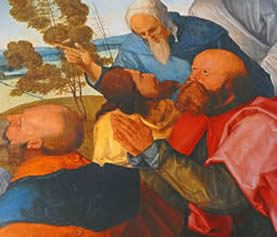
Figure 3
Heller Altarpiece
Detail of praying Apostle,
Central panel, lower right
Historisches Museum, Frankfurt, Germany

Heller Altarpiece
c. 17th century, Jobst Harrich
Complete view of all inside panels
Historisches Museum, Frankfurt, Germany
The triptych includes two male figures with their hands in prayer. Near the top of the left panel, Harrich’s patron saint, St. James the Elder, is kneeling in prayer, with his hands oriented left-to-right toward the scene in the central panel of the altarpiece. The saint’s hands do not resemble the Praying Hands, but the other figure’s hands are the same as those in the drawing. The second figure is an unidentified Apostle, kneeling in the lower right corner of the central panel and praying with his hands oriented right-to-left. The drawing on blue-grey paper now known as the Praying Hands was the preparatory study for this Apostle’s hands.5 As far as we know, the preparatory drawing was not intended by Dürer to be viewed in isolation. However, the fact that it was preserved as a separate artifact has enabled the hands to receive a degree of attention which they probably would not have attracted in the context of the altarpiece as a whole.6
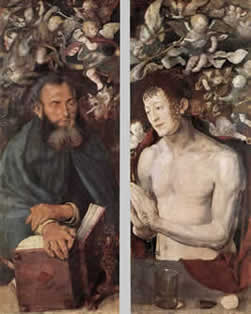
The Dresden Altarpiece
c. 1497, Albrecht Dürer
Side wings
Gemäldegalerie, Germany
The Praying Hands in Dürer’s drawing are thin, with elongated fingers and well groomed nails, not calloused from manual work. The forearms are elegantly clothed, with sleeves made of expensive material, obviously the dress of an affluent person. The tendons and veins of the hands are beautifully depicted. These hands show mild aging at the little finger joints. They present no inflammatory swelling, but the right little finger is slightly bent at the proximal small joint level. On the left hand, the thumb is extended rather than in a normally flexed position. The left ring finger, with its slightly flexed proximal and extended distal joint is suggestive of Boutonniere’s deformity.
Pankaj Sharma, a physician engaged in clinical research, has provided a detailed commentary on the possible pathologies depicted in Dürer’s drawing.7 He notes, for example, that the two hands are only lightly touching. They are neither pressed flat against each other nor clasped together with the fingers interlaced and curving around the opposing hand. Hence he suggests that their positioning could be the result of muscle wasting and neuropathy associated with diabetes mellitus. The bent little finger on the right hand, which he identifies as a possible instance of Dupuytren’s contracture, is also presented to support the diagnosis of diabetes mellitus.
It should be noted, however, that the above features are not necessarily pathological. The fact that the hands are lightly pressed together cannot be taken as evidence that holding them flat or clasping them together would be painful. The lightly-pressed position is so common in the art of the time that it could be interpreted as a cultural and stylistic feature rather than a pathological sign. Similarly, when the hands are in this position a bent little finger is commonly shown in artistic representations of the period. So this feature is probably also stylistic—adding a note of graceful elegance to the hands rather than indicating a permanent deformity.
An alternative diagnosis offered by Sharma is rheumatoid arthritis. In this context, he calls attention to the deformed shape of several fingers and the position of the left thumb. In addition, he notes the prominence of the middle tendon on the left hand and some swelling of the wrists, both suggestive of synovitis. It is these relatively unequivocal signs of pathology identified by Sharma which support his conclusion that the hands in Dürer’s drawing are an expression of human suffering as well as religious piety.
The hands of Dürer’s St. Sebastian
It is noteworthy that a similar pair of hands in prayer can be seen in Dürer’s Dresden Altarpiece, now on display in the Gemäldegalerie in Dresden, Germany (Fig. 4). The central panel of this triptych was completed around 1497, and the two side panels, which concern us here, were added about 1504.8 The left panel depicts St. Anthony with hands that are severely deformed, but not held together in prayer. Dürer himself suffered from a familial arthritic condition which involved the joints in his hands, and he was keenly aware of such deformities.9 Opposite, on the right panel, St. Sebastian is shown praying with his hands in the same position as those in the Praying Hands preparatory drawing.
Comparison of the hands in the St. Sebastian panel of 1504 and the Praying Hands drawing of 1508 permits the superimposition of the two images, revealing their obvious similarity (Fig. 5b, c). It would not be uncommon for an artist of this period to use the same image in different works a few years apart.
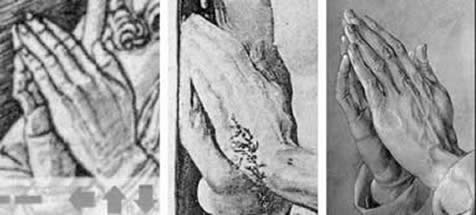
Comparative images of hands in prayer
From left to right:
a. Mantegna’s St. Longinus; b. Dürer’s St. Sebastian;
c. Dürer’s Praying Hands.
Praying hands in this position were not a stereotyped feature in Dürer’s work. For example, a number of males are shown with their hands in prayer in Dürer’s Feast of the Rose Garlands, dated 1506 (Fig. 6).10 Although this painting was completed in the interval between the St. Sebastian wing of the Dresden Altarpiece (1504) and the Praying Hands (1508), none of the praying male figures has his hands in the position shown in the other two works.
Was there a model?
A specific model for Dürer’s Praying Hands has not yet been identified. The pathological features of the hands in Dürer’s drawing have suggested to Sharma that they were the hands of a person whom Dürer drew from life.11 However, many of these same features enable us to argue that the hands in question are based closely on those in the work of an earlier artist.
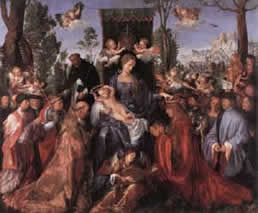
Feast of the Rose Garlands
c. 1506, Albrecht Dürer
Národní Galerie, Czech Republic
This earlier artist does not appear to have been German. We have found no similar hands in the paintings and woodcuts of Michael Wolgemut (1434–1519), Dürer’s teacher in Nuremberg. A male with praying hands appears in The Adoration of the Magi, an engraving by Martin Schongauer (c. 1450–1491), who was “the most influential graphic artist in Northern Europe in the last quarter of the fifteenth century”12 Dürer had an obvious interest in Schongauer’s work because he once journeyed to Colmar to meet the older artist, but unfortunately Schongauer had already died by the time Dürer arrived.13 Nevertheless, the hands of the praying magus in Schongauer’s Adoration of the Magi are not the same as those in Dürer’s drawing.
Given the importance of Dürer’s artistic development in Italy, it is appropriate to consider whether an Italian artist may have furnished a model for the Praying Hands. There is no diary of Dürer’s travels to Italy, but his route can be reconstructed from the landscapes, portraits of local personalities, and images of flora and fauna which he produced at each point of the journey. Via Basel and the Brenner Pass, he entered Northern Italy proceeding to Venice, but probably venturing to Padua, Mantua, Cremona and Bologna as well.14

The Risen Christ between Saint Andrew and Saint Longinus,
c. 1472, Andrea Mantegna
The Metropolitan Museum of
Art, New York
While in Italy he observed and copied works by Giovanni Bellini (c. 1430–1516), Lorenzo di Credi (c. 1459–1537), and Antonio Pollaiuolo (c. 1432–1498).15 Dürer’s most important copies, however, were made from mythological engravings of Andrea Mantegna (c. 1431–1506), namely the Battle of the Sea Gods and the Bacchanal with Silenus. Panofsky noted the technique used by Dürer to replicate Mantegna’s figures: “In these copies, the contours are directly traced from the originals; only the modeling is entered in free hand.”16
The hands of Andrea Mantegna’s St. Longinus
Andrea Mantegna frequently represented males with praying hands,17 but only one close match can be found between the hands depicted by Mantegna and Dürer’s Praying Hands. The relevant work is Mantegna’s engraving of the Risen Christ between St. Andrew and St. Longinus, dated 1472 (Fig. 7).18 On the right side of the picture, St. Longinus holds his hands together in prayer. They are well groomed, oriented from right-to-left, and dressed with elegant sleeves. As in Dürer’s drawing, the fingers are elongated, the left thumb is extended, and the right little finger is bent at the level of the proximal small joint.
The hands of St. Longinus are similar to the hands of St. Sebastian in the Dresden Altarpiece and nearly identical with the Praying Hands in the Albertina Museum. The only significant difference between the Praying Hands and those of St. Longinus is the absence of a prominent middle tendon on the left wrist of Mantegna’s figure. This is a feature that does not affect the outline contours of the hands but is instead a matter of detail that Dürer could have added if he were working with a tracing of Mantegna’s St. Longinus.

Comparative tracing of the hands in prayer
by: a. Mantegna, b. Dürer.
With the same contour-tracing technique that Dürer used on Mantegna’s engravings, images of the hands can be superimposed on a computer screen at several reference points, such as the tip of the middle fingers and the bent right little fingers, with an almost complete congruence (Fig. 5a, c; Fig 8). The expensive sleeves in both images also support the theory that Dürer’s Praying Hands of 1508 are likely to have been modeled on Mantegna’s St. Longinus in the Risen Christ between St. Andrew and St. Longinus.
Conclusion
Dürer’s exposure to the Renaissance culture of Italy was the most important influence on the development of his art; his “visual quotation” from Mantegna in his Praying Hands of 1508 can be understood as a form of homage to that culture. Seen in this light the Praying Hands—far from being reduced to a kitsch icon—have a twofold spiritual significance. Through their pathological features they express humanity’s suffering and dependence on divine aid, while at the same time through their reference to Italian art they celebrate humanity’s creativity and cultural renewal.
WILLIAM R. ALBURY, PhD, is adjunct professor of History in the School of Humanities at the University of New England in Armidale, Australia. His principal research interests are the history of science and medicine (ca. 1500–1900), the use of medical and cosmological metaphors in political thought, and social history as reflected in works of art. His most recent publications in these areas are: G. M. Weisz, Marco Matucci Cerinic, W. R. Albury and Donatella Lippi, “The Medici Syndrome: a Medico-Historical Puzzle,” in International Journal of Rheumatic Diseases; W. R. Albury, “Medicine and Statecraft in the Book of the Courtier,” in Intellectual History Review; and W. R. Albury and G. M. Weisz, “Depicting the Bread of the Last Supper: Religious Representation in Italian Renaissance Society,” in Journal of Religion and Society.
GEORGE M. WEISZ, MD, FRACS, was trained as an orthopedic and spinal surgeon in Israel, the USA, and Canada. He has been in practice in Sydney since 1975. His interest in history and the arts led to a BA degree in European History at the University of New South Wales and to an MA in Renaissance Studies at the University of Sydney. His present research continues on both medical and historical lines, more specifically on “ghetto doctors’ contributions to medicine” and “medical history hidden in Renaissance paintings.”
Highlighted in Frontispiece Volume 3, Issue 1 – Winter 2011
